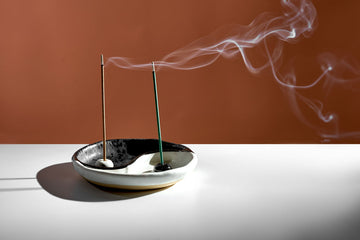Chinese incense reflects centuries of tradition and natural healing. These scents have long played a role in daily rituals, temple offerings, and personal well-being across dynasties. Each type carries its own history, purpose, and aroma—offering calm, clarity, or gentle stimulation depending on how it’s used.
In this guide, we highlight five of the most respected traditional Chinese incense types. Known for their purity and distinctive properties, these selections represent the essence of Chinese aromatic practice.
1. Agarwood (沉香)

Scent Profile: Deep, rich, warm, slightly sweet and woody
Best For: Stress relief, grounding, deep rest
Ideal Moments: After work, during evening reading, or before sleep
Agarwood is one of the rarest incense materials in the world. It forms inside Aquilaria trees when they naturally produce resin over many years. In ancient China, agarwood was used in imperial rituals, Buddhist meditation, and as a healing scent in traditional medicine.
Agarwood is believed to support qi flow, ease chest tightness, and settle restlessness. Many users say burning it for just 10 minutes helps them feel more centered at the end of a long day.
Why It’s Among the Best:
-
Used in high-level rituals and temples
-
Helps with sleep and emotional clarity
-
A symbol of luxury and spiritual depth
2. Sandalwood (檀香)

Scent Profile: Soft, creamy, smooth, slightly sweet and dry
Best For: Mental focus, gentle relaxation, daily calm
Ideal Moments: During work-from-home hours, studying, journaling
Sandalwood has long been burned to quiet the heart and calm scattered thoughts. It is often used in both Buddhist and Daoist ceremonies and helps create a peaceful mental space for study, meditation, or rest.
In traditional Chinese medicine, sandalwood is said to clear heat and support the lungs. Its gentle nature makes it ideal for daily use, even in busy households.
Why It’s Among the Best:
-
Supports mental clarity and steady breathing
-
Easy to blend with other herbs
-
A familiar scent for many beginners
3. Mugwort (艾草)

Scent Profile: Herbal, earthy, slightly sharp and cleansing
Best For: Energy clearing, respiratory comfort, seasonal shifts
Ideal Moments: After house cleaning, during spring refresh, or while airing out indoor spaces
Mugwort is a traditional herb used in both incense and Chinese medicine. It is commonly used during moxibustion to support energy flow and remove dampness.
When burned as incense, mugwort is believed to purify the air, support easier breathing, and lift low mood. Many families use it in spring or autumn to freshen the energy of their homes.
Why It’s Among the Best:
-
Known for its cleansing and protective properties
-
Helps ease blocked airflow
-
Often used in cultural rituals for space clearing
4. Ambergris (龙涎香)

Scent Profile: Smooth, warm, marine, subtly musky with sweet undertones
Best For: Emotional balance, refined relaxation, spiritual depth
Ideal Moments: During reflective journaling, solo evenings, or art and music sessions
Ambergris is a rare substance produced naturally in the intestines of sperm whales, eventually released into the ocean and aged by salt, sun, and time. After years of natural curing, it becomes waxy and fragrant. In ancient China, ambergris was highly prized by royal courts and scholars for its ability to stabilize emotions and enhance high-level incense blends.
Its scent is both grounding and uplifting—calming the mind while awakening inner clarity. Due to its rarity and deep aroma, it is often reserved for important rituals or personal reflection.
Why It’s Among the Best:
-
Exceptionally rare and traditionally regarded as a treasure
-
Enhances spiritual awareness and inner harmony
-
Historically used in palace-grade incense recipes
5. Frankincense (乳香)

Scent Profile: Resinous, bright, lemony with warm depth
Best For: Mood lifting, breath regulation, spiritual balance
Ideal Moments: Early morning stretches, yoga practice, or during breaks for clarity
Although native to the Middle East, frankincense has long been included in Chinese incense recipes, especially in Taoist temples. It is used to deepen breath, awaken the senses, and support emotional healing.
Its scent is comforting without being too heavy. When burned in the morning or during meditation, frankincense helps open the senses and refresh the atmosphere.
Why It’s Among the Best:
-
Balances the nervous system
-
Works well alone or in herbal blends
-
Deep roots in global incense culture
Are These Incense Types Safe to Burn at Home?
All five incense types listed above are made from natural herbs, wood, or resins—with no synthetic fragrances or chemicals. They are generally safe for most people, children, and pets when used in a ventilated space.
However, everyone reacts differently to scents. If you notice any discomfort such as sneezing or irritability in children or animals, stop burning the incense and allow fresh air into the room.
Always place incense out of reach, never leave it burning unattended, and keep the space well-ventilated.
Embracing Incense in Daily Life
Traditional Chinese incense is a quiet companion in daily life. These five selections have been treasured for generations due to their grounding presence and connection to nature.
Each type contributes a subtle shift to how you feel—whether that’s a softer mood at bedtime, sharper focus while working, or a sense of calm in the background of your daily routine. Integrating incense into modern living is less about ritual and more about restoring the atmosphere that supports how you want to feel each day.




